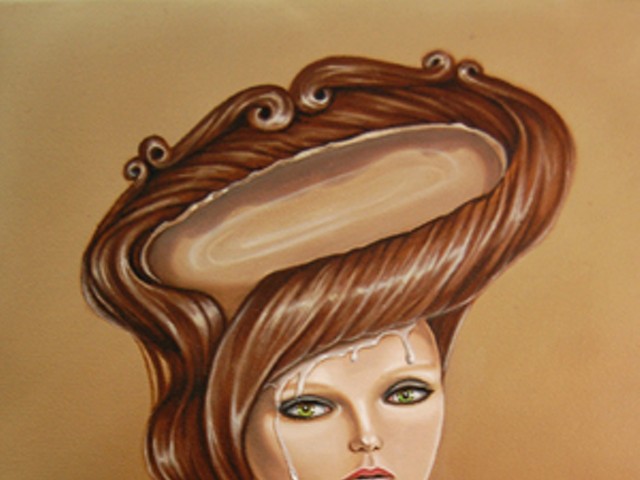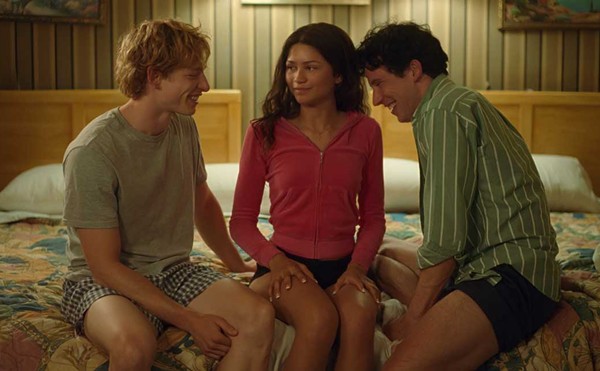Josh Band earned his living designing building-sweeping robots for the Department of Defense. Now he's a photographer. Few publications as yet have featured his work but you'd be hard-pressed to find a (working) model or stylist who doesn't know him, and roving gallery-goers in four Michigan counties have, at some point, paused at one of his stills to gaze into his world. His is one of those "anything's possible" kind of places. In fact, Band's photography extends far beyond the parameters of composition — framing a shot is habit, the rule of thirds instinctual. Pushing into the abstract with a delicate hand, Band's digital process is a series of scrapes, bleaches and stretches that result in multitudes of entrancing textures.
In fact, if you glance over his shoulder as he tweaks a photo on his computer, it's as entertaining as just about anything you'll find on a computer screen. No kidding. Some photos are treated with restraint — maybe just a crop, some color adjustment, dodges and burns — while others are completely overhauled and only a trace of photography lingers like a vague idea somewhere in the image's intangibilities. In these more "ethereal" elements of his work, anything "real" bleeds softly out of the shot and what you're left with is contorted, often eerie, but always beautiful.
The guy who went from writing code for the Department of Defense and NASA shoots haute couture. He also captures the beauty of Detroit's haunted blight, and the Motor City's creative core has come to love him.
Metro Times: Tell us about the first time it really "clicked" in your head, that point when you knew you had some kind of an artistic bent?
Josh Band: Definitely as a child. My grandfather was an optometrist by day and, in his off-time, he worked in his basement studio as an artist; he never really exhibited his work, primarily just creating art for art's sake. Any given visit would introduce us to a new craft — throwing clay on the potter's wheel, making jewelry, painting with oils, and, of course, the darkroom.
MT: Where's your studio-work space?
Band: I easily transform any space into my studio and I'm often shooting on location. When I don't want to lug around all my gear, I shoot out of my apartment. It works. My living space is on the second floor and studio space is on the third. It'd be nice to have a giant studio, but I've always been good working with what's available to me.
MT: Did you study art at college or university level? Are you self-taught?
Band: Outside of my grandfather's darkroom, I took a handful of miscellaneous studio art courses at University of Michigan while I was working toward my Computer Science BS. University of Michigan, at least at the time, had a pretty horrible art program, especially photo. I honestly hope things have changed. About three years ago or so, I picked up a digital camera. After that, I taught myself everything I know by just jumping in.
MT: So it's fair to say you're not a purist?
Band: I had a film SLR in high school, but that stayed pretty dusty until just recently. I ended up finding photography again after playing with a pocket point-and-shoot digital and getting surprisingly good feedback. That camera, with all its limitations, was what really taught me that a camera is purely a tool and it doesn't matter what you're using.
MT: What's been the biggest obstacle thus far?
Band: It's that photography is expensive! You really never stop acquiring gear. Once you have all that gear, it's a lot of work moving it around. When you have to move it around, gear can break because it's worn down. Then you have to rebuy it. Repeat. Another big one has been finding a substantial community of cohesive artists.
MT: How do you view the Detroit art world? Is it tight-knit or fractured? Do you feel like you fit in?
Band: Completely, completely fractured. It's part of the city's nature. There are a lot of great artists, but folks are generally dispersed and disorganized — the "jewel in the rough" theme is pretty common. I guess there are certainly hubs for artists — the Russell, Scarab Club, 555 and 4731 — and I fit in with some better than others, but there isn't really a central community. I wish there were a "Justice League" for artists. ...
MT: Many people cite the city of Detroit as an influence on their art in one way or another. Do you think Detroit has inspired you?
Band: Initially, I went through an urban explorer phase, touring the ruins of Detroit. I think most photographers living in Detroit do. Fascinating shapes, post-apocalyptic scenes, slices of the industrial age, peeling paint and crumbling facades are great eye candy and make for pretty easy subject matter. I like to take pictures of the walls, cement floors, dirty glass, burned wood and such for my collection of textures.
MT: Have you encountered ageism as an artist?
Band: I look like I'm 20 and still get carded for R-rated movies and laughed at when I want to order a drink. Yeah, I run into it. If I want to shoot on location, people are often suspicious of my intentions because I look young, as if I'm "up to something." I also think that there is a pretty big divide between younger and more "mature" artists in Detroit.
MT: One of the threads that ties all art together is the painstaking inevitability of finding finalization. How do you know when nothing more can be added or should be subtracted?
Band: Photography has the unique quality — at least some have this perspective — that when you push the button, you're done creating. That's a massive oversimplification but, for a lot of photographers, they're done immediately after composing. For me, I'm about half done. I love setting the stage with lighting and such and working with my subject, however I really spend most of my time editing and styling my images. I may spend days on a single image, fine tuning, adjusting, aging, warping. I could work on an image forever.
MT: Are you a lone gun or are you cool with collaborations?
Band: I love, love, love collaborating. Photography, by its very nature, is a solo act. One person can press the button. That being said, I've been working with another photographer, Juel Zamplas (Uptown Photography) on many shoots. We play off each other extremely well. If she's working with the camera, I might be tuning the lighting or directing the model. She'll focus on the fine-tune and retouching and I'll work on the global image styling when we're in post-production. We seamlessly operate as a unit when we shoot together, which is fairly unique for photography, I think.
MT: You recently got together with an artist for a show at CPOP. I remember hearing something about sausage. ...
Band: I recently had the pleasure of collaborating with Cristin Richard, a 3D sculptural artist and fibers artist. She fashioned wedding dresses for our models made from sausage casings, which may sound gross, but it's absolutely beautiful when lit properly. Her work is stunning. Our joint work was shown in a group show last month called Live Conformists Dead Troublemakers.
MT: What was the last thing that knocked you off your feet?
Band: Learning about the photographic technologies and artists of the mid-19th century. They're impossible to replicate digitally. There is no way one can create daguerreotype photo with contemporary technology. It's just not doable.
MT: Do you have a mantra?
Band: Like "if you build it, they will come?" No, I don't have a mantra. I apologize a lot. I always say, "I'll be there in five minutes," and then end up showing up 30 minutes later. I run on creative person's time. Then I apologize. If I break something, I'll say "poor design," which is something my grandfather always used to say.
See more at joshuabandphotography.com.





